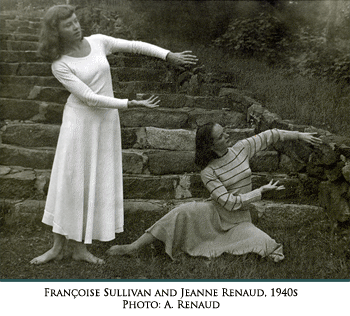 | ||||||||
| ||||||||
 | ||
In addition to writing "La dance et l'espoir", in the first few months of 1948, Sullivan was busily making notes for a "Studio Evening" to feature herself and her students from the Crevier school performing as "Françoise Sullivan and Group". The only record of the Studio Evening is the handwritten copy of the playbill. Therefore it is unclear if this performance actually occurred. Nevertheless, it provides documentary evidence about the different choreographic works Sullivan was preparing at the time. These dances included Déploration sur la mort, Lucrezia Borgia, Black and Tan Fantasie and The Mask of the Red Death. This last dance was based on Edgar Allan Poe's 1842 short story, "The Masque of the Red Death", which was about a prince who seals off his palace to prevent the plague from entering. Not knowing that he has actually sealed in the "Red Death", the prince and all his guests die during a masquerade. Sullivan was to dance the part of the Red Death. Another choreographic work included in Sullivan's notes for the studio evening was a piece called The Maze. This solo was possibly the same as Sullivan's iconic dance Dédale, which translates into English as "maze" or "labyrinth". This minimalist work concentrates exclusively on the repetitive swing rhythm of the dancer's body to create and communicate meaning. The dance begins with small movements that gradually gain enough force to carry the dancer through space: the slow, almost imperceptible curl and flex of the dancer's right wrist builds until the dancer's entire body swings back and forth so violently that she is propelled across the stage. The ebb and flow of momentum is also built within the structure of the piece as movement dies down in one section only to swell again in the next. As Sullivan wrote several years, Dédale was inspired by "the movement of the pendulum." It was a piece composed using the movement of "ballant" or "swing". The dancer lets herself flow with the weight of her body, oscillating with the rhythm of the energy that gains momentum, and arriving at a climax ... then ending abruptly. No sets, no music, only the sound of the dancer's breathing. The original costume for Dédale, like the dance itself, was minimal: a light pink leotard and a skirt that fell to Sullivan's mid-calf. Dédale was initially choreographed with a headpiece vaguely reminiscent of a bird cage that was designed and created by Automatist member, Jean-Paul Mousseau. At the end of the piece, the dancer raises her hands on either side of her head and extends them forward, outstretched. Sullivan had intended to lift the headpiece off at the end of the dance and hold it in offering to the audience. Dédale is often seen as Sullivan's most effective application of Automatist theory. The work is nonfigurative in the sense that it is "pure" movement, with no imperative beyond the exploration of kinetic energy. The connection of the dance to Automatist ideals is supported by Sullivan herself who has written that in Dédale she tried to "let flow objective chance, compulsions, non-premeditated meetings, unpredictable relations and a search for simple, elementary and sometimes unusual movement." Dédale plays with and sculpts space by exploring the impetus of the swing, a movement that in Sullivan's dance makes itself available to emotion. Within the Ausdruckstanz tradition of the modern dance style Sullivan studied at Boas' studio, the primary purpose of dance was to make the body a conduit for emotional expression. Thus, the seemingly simple action of swinging not only moves the body through space, but also opens it to an emotional intensity; the fervour required to perform the dance becomes visible as each swinging motion becomes more forceful and violent than the last.
Most likely Sullivan's "Studio Evening" with her students did not happen in the spring of 1948, but was instead commuted into a recital Sullivan organized with her friend and sister of Jeanne Renaud, Louise Renaud, with whom Sullivan had initially stayed in New York. Jeanne Renaud had been in New York also studying dance during part of the same period as Sullivan. In fact Renaud had even attended one of the Boas Dance Group's lecture demonstrations, but had elected to study with Hanya Holm and Mary Anthony. Nevertheless, once back in Montréal both Renaud and Sullivan worked as colleagues, often appearing in each other's choreography. (next page) ©2006, Dance Collection Danse | ||

